Recently we’ve been introduced to the geniuses at Strong Towns. First they gave us the stunning and brave insight that downtown urban areas in Manhattan have higher property costs per acre than farmland in Kansas. Then they explained how ACKSHUALLY street parking shouldn’t exist. You see, a Covid-19 era policy showed the restaurants in Toronto – which were not legally allowed to serve customers indoors – made more revenue in the physical location where the parking spot was serving customers than the city made in parking fees. Therefore street parking is unnecessary and in fact counterproductive.

It’s confusing because it’s stupid. I had to make sure that everyone knows that we are not dealing with serious and rigorous people, before diving into this. Serious societies need careful urban planning. Strong Towns and the Urbanite Bugcreatures aren’t it.

It’s with this in mind that we evaluate their claim that suburbs, as opposed to the inner cities of colour, are secretly subsidized.
Strong Towns – The Growth Ponzi Scheme Part 1(2011):
The underpinnings of the current financial crisis lie in a living arrangement—the American pattern of development—that does not financially support itself. The great experiment of suburbanization that America embarked on following World War II has no precedent in human history. As it enters its third generation, the flawed assumptions that were overlooked are now coming back to bite us in a cruel way. Like any Ponzi scheme, there is only one way this ends.
I had no idea that the suburbs were holocausting our prosperity. Look at this horror show!

There is a bit of a problem here that needs clarification, since there are two types of suburbs. There are suburbs that are actually part of a city, and have the same taxpayer base and expenses as the rest of the city. Essentially these suburbs can be thought of as the non-downtown part of the city.
But most suburbs, in my estimation, are entirely different municipalities altogether. Below we see a suburban house in the Greater Vancouver Area. Quick, is it in Burnaby or Vancouver?
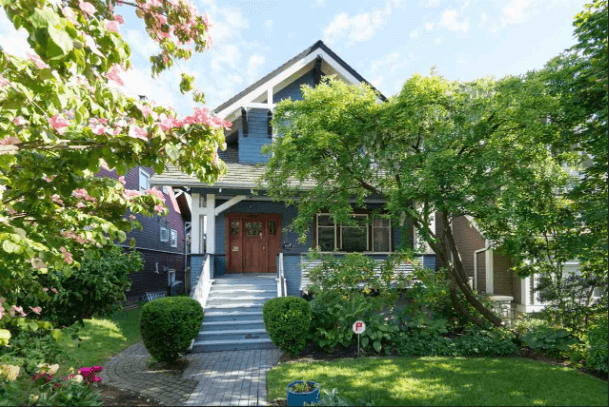
Kitsilano (Vancouver neighbourhood) house.
This one is in Vancouver, but it could just have well been Burnaby. In the former case, it could theoretically be possible that the rich shitbags and multinational conglomerates who own the skyscrapers are subsidizing the people who live in this house. To that I say, good.

If the neighbourhood was in Burnaby it couldn’t possibly be subsidized by the skyscraper owners property taxes. The city of Vancouver cannot bankrupt itself funding unsustainable suburb development in the city of Burnaby, even though that’s one of its suburbs. One of the narratives of the Traffic Trannies is that the “unproductive suburbs” are subsidized by the “productive” downtown areas, and therefore bankrupting them. That is simply not how things work.
For the Americans, this is like saying that Newark is a suburb of NYC, therefore they just steal some NYC property tax revenue for dem programs. Of course the Newarkians are stealing your tax dollars, but not in that way. They’re also stealing your wallet if you don’t keep that clutched close to your body, so head on a swivel. Around Newarks, never relarx.

There is so much murky reasoning around most of what the Traffic Troons talk about, which is why I’m making this crystal clear right from the outset. Suburban development being unsustainable – it’s not but we’re accepting the premise for now – doesn’t need have any ramifications on the finances of the nearby city. This is only true if the suburb is actually located within the city limits, which is rare in North America.
If the suburb is its own municipality, the premise of the “Suburban Growth Ponzi Scheme”, while dumb, could still be somewhat true. However, development would then be subsidized by the federal and state governments. In that case, we would need to look at the net taxpayer finances of those areas. Do you really believe for one second that the White families above and below are anything other than net taxpayers?

Of course they are. And if it were true that suburban development was partially subsidized by higher levels of Government, good. The people who live in the cities get a whole lot more from our tax dollars then we do.
Jaime, can we pull up an image of those Newarkians again please?

Can you believe that these fine gentlemen of colour are secretly funding the Whyties in the suburbs?! What an outrage!
In the great American experiment of suburbanization following World War II, we redirected our country’s extensive resources into a living arrangement unseen at any point in human history. We abandoned thousands of years of history, knowledge and tradition in building cities and towns in order to try this new — and completely untested — approach.
I had to say all the above, to say this now. Suburbs have absolutely existed throughout history. Only by redefining what “suburb” means can these people pretend otherwise.
Cambridge Dictionary (Definition of suburb):
An area on the edge of a large town or city where people who work in the town or city often live.
Do you think people back in 1500 BC threw up their hands when they reached the current outer limits of a city and moved to some random spot on the map? Of course not, they just built wherever the current edge of the city was and carried on.

Dubrovnik, Croatia
That’s why plenty of European and Asian cities have concentric walls running right through them that the city outgrew. That’s not a modern phenomenon that required General Motors to engage in some streetcar shenanigans. People have been building on the outskirts of cities since they have existed.

Toledo, Spain
They walls were built, the city expanded beyond them. They were built again, the city expanded further. In the case of Jerusalem, many different walls were built over many eras, and around a very changing city. So much so that the walls nowadays appear almost random.

Jerusalem, Palestine
I say all this, because it really annoys me to watch these Urbanites pretend to care so very deeply about affordable housing. Case in point, the geniuses at Vox.
You see, there has never been a group of people who care more about affordable housing than these people, Goy. They’ve cornered the “caring about affordable housing” market. If you don’t like them and refuse to mindlessly repeat their cult talking points then you just think that people should be homeless and starve to death, you NIMBY.
They can’t be bothered to talk about migrants driving prices through the roof, or Larry Fink’s Blackrock buying up all the houses so as to price out normal people. But other than ignoring the two most important factors in making housing unaffordable, they totally care about affordable housing. They care so much they’re giving the philanthropist with a heart of gold, Michael Bloomberg, a run for his money in the “caring about affordable housing” department.
And yet for some reason, they totally hate suburbs.
Boy do they ever hate suburbs.
There is a level of suburb hate going on here that shouldn’t even be possible.
Who wouldn’t hate the things that destroyed America? You know, the 1960’s Hart-Celler Act suburbs.
After all, having our money stolen for fake refugees and wars for Israel suburbs make us poorer, and these are fiscally responsible antifas who are having none of that.
They hate suburbs as much as they love affordable housing. Which is odd, because suburbs are another way of saying “affordable housing.” Sure, the below image is an artificial monstrosity. I covered this all the way back in the second piece. But what do you think costs more, these houses or a cuckbox in a Manhattan skyscraper?

We can’t grant these anti-White fags the premise that they actually care about walkabilitywhen they constantly ignore crime. And we can’t grant them the premise that they care about affordability when they’re snarking about how Whitey in the suburbs has too much house because something something global warming.
No group of people care less about affordability than Xir Urbanites. If they did, they would be praising cars because automobiles allow people to live on cheaper, more distant land.

Again, I am not defending totally sterile and totally artificial suburbs, where no one is legally allowed to build any of the necessities of life. But there is a big difference between saying “don’t build artificial garbage that no one wants,” and whining that people are building their houses on the cheapest land, instead of cramming themselves into a coffin sized Manhattan condo that costs $7 million.
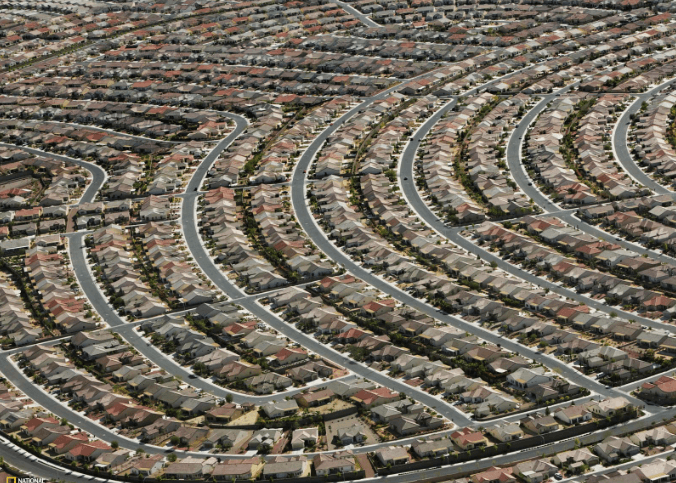 To Xir Urbanite, affordable housing isn’t building on the cheapest land at the outskirts of town. Affordable housing is about having taxpayer subsidized gay fuckparties in the tastefully diverse downtown areas.
To Xir Urbanite, affordable housing isn’t building on the cheapest land at the outskirts of town. Affordable housing is about having taxpayer subsidized gay fuckparties in the tastefully diverse downtown areas.
ReasonTV is a LOLbertarian rag, and I’ve mentioned the mixed bag that is Randall “anti-planner” O’Toole before. Having said that, he raises some obvious and uncomfortable points that Big Soy doesn’t want talked about.
(1:51) Randall O’Toole Speaking:
The truly affordable housing would be low density housing built on the urban fringe. The goal that urban planners have had for many years is not to make housing more affordable, but to pack people in to higher density urban areas. And that’s a goal that I don’t think Americans should support.

Don’t get two excited, this is two retards fighting. As if to prove that, immediately after interviewing Randall O’Toole the Libertarian bugcreatures take the side of California state senator Scott Weiner.
Restricted zoning ensures that housing is perpetually expensive, and out of reach of most Californians.
For years [Senator Scott Weiner] has been pushing State Bill 50, which would make it easier to build midrise housing near local transit stops by overriding local zoning rules that only allow the construction of single family homes.
This is the same (((Scott Weiner))) who wrote legislation reducing the penalties for knowingly transferring HIV to someone without their knowledge, or donating blood that you know is infected with HIV. It passed, by the way.

Scott Weiner is one of the grossest and most malicious legislators in America. Rest assured, if you find yourself on the same side of him in an argument, either something has gone horribly wrong, or hell has indeed froze over.
This reminds me of the Great Zoning Laws Finklefight, covered in the third piece. And I’d recommend that you check out the non-LOLbertarian take on land restriction. In short, Scott Weiner wants to force Squatemalan migrants down the throats of the few White enclaves left in California, and we don’t need to grant him an inch. He’s just trying to destroy suburbs because White People with intact families live there.
However, the video improves as they interview O’Toole again.
(8:00)
In an urban area that doesn’t have growth restrictions you can buy a new house for as little as $100 per square foot. Midrise housing typically costs $500 per square foot. And high rise housing costs $6-800 per square foot. So how does that housing become affordable? It becomes affordable by building tiny units. And we call that affordable housing.
You don’t need to be a LOLbertarian to understand that housing built on naturally less valuable land is going to be cheaper than housing built on ultra expensive downtown areas. After all, empty lots in Hong Kong can sell for more than $3 billion per acre. And prices like this are standard.

It is totally insane that the “affordable housing” crowd is opposed to “suburban sprawl.” There is no reason to start with forcing “densification” on people when you could just remove urban growth boundary restrictions in many areas and immediately start building cheap housing.
Then again, it’s insane to talk about walkability and public transit without mentioning crime, but the Traffic Troons manage.
Most Americans, even millenials, will prefer living in more spacious, less dense settings. He points to census data showing more 25-30 year olds are moving from cities to suburbs than the other way around, and a recent Gallup poll finding only 17% of young people saying they want to live in a big city.
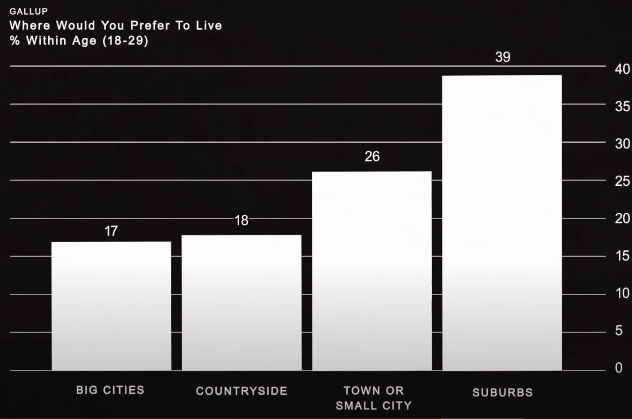
This is of course true, but it’s comical how libertarians and urbanites have this gentlemen’s agreement to never mention crime. There’s nothing particularly strange about young people not wanting to pay through the nose to live around “culturally enriched” locations.

At least O’Toole doesn’t make this about some nonsense like “getting away from the communist urban planners,” and simply remarks upon the phenomenon.
Urban planners have spread these myths in order to justify their goal of increasing urban densities. But that’s not the way Americans have wanted to live for the last hundred years, and there’s no sign that American tastes have changed.
Yes to the first part, not so sure about the rest. Let’s try urban living without a certain group of criminal and see how we like it.

O’Toole somewhat redeems himself with the following.
[Urbanites] believe that if we let the free market work, we will end up with people living in higher densities. But they’ve never said “let’s get rid of the urban growth boundaries. Let’s let the whole free market work.” No, they only say “let’s get rid of single-family zoning.” That’s not a free market.
Funny how the evil kike Scott Weiner never suggested that, and went straight to the “let’s destroy nice White neighbourhoods,” bit. That’s so odd. I can’t figure him out.

We can ignore O’Toole’s free market worshipping, because his overall point, while common sense, is undoubtedly correct. The reason why cities have to put up land usage restriction boundaries is because, if they didn’t, people would build cheap homes and accompanying businesses, schools, hospitals, etcetera on them. 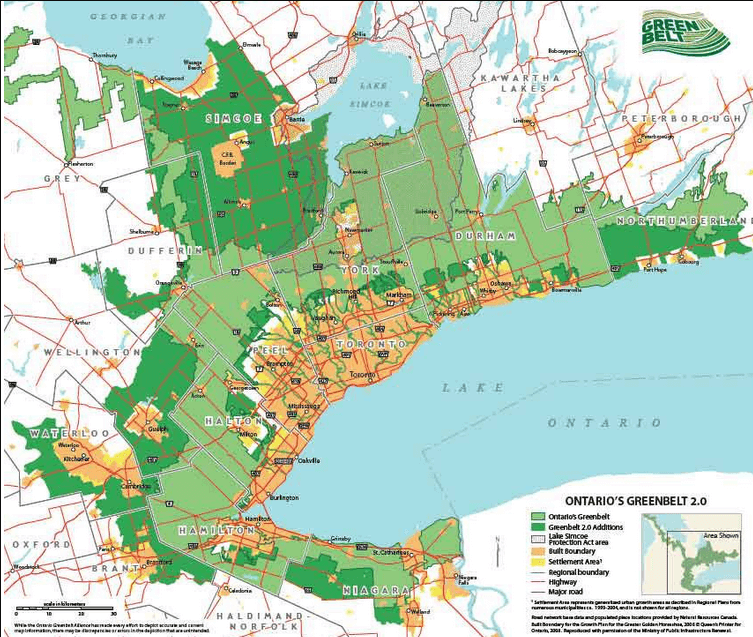
Sprawl is the natural form of cheap housing, and has been for thousands of years. The traffic antifas whine about the artificiality of zoning laws creating single family houses right next to skyscraper apartment buildings. Then they stay silent as the grave on the dubious policy of setting aside enormous amounts of land for farming, as if Canada and the US are down to our last half acre of arable farmland.

Pretending that sprawl is a new and bad thing is one of these obnoxious and bizarre cult beliefs of the Urbanites. Downplaying the logic of building affordable housing in suburbs is as weird and unjustifiable as them pretending that horses never existed, that crime isn’t the dominant factor in walkability, that public transit – even in a beautiful all White country – can replace personal transit, and that we can ban cars and not starve to death.

Building on the outskirts of town is the traditional way of providing affordable housing. This is not up for debate. It is simply a fact. There are no arguments against this. You don’t get to pretend to be in favour of affordable housing unless you are in favour of three things.
- No more migrants.
- Put Larry Fink in jail for intentionally buying up homes and forcing Americans out of theirs.
- Getting rid of land usage restrictions that prevent people from building the homes where they would like, which is the outskirts of cities.
- (Bonus) Bringing back jobs to heartland areas, to make people less interested in moving to the cities in the first place.
Instead, Xir Urbanfags skip ahead to demanding that the single family neighbourhoods that White People want to live in be forcibly converted into highrise apartments for dem inner city keedz.

For the record, it’s entirely fine to argue in favour of greenbelt-type restrictions. You just can’t credibly call yourself an affordable housing advocate when you do so, since you are preventing the most affordable housing from being built. There are many benefits to farmland, and I think there is a reasonable argument to be made that it should be somewhat subsidized near cities. One day we will progress to the point where things such as farmland subsidies are the most important issues, and not the WMD Liars being unpunished while we face mass censorship.

I have say all of the above, because the claim by Strong Towns and the Traffic Soyboys is that suburbs are inherently Ponzi schemes. Not that there is some loophole that some municipalities here or there can take advantage of in order to irresponsibly get some quick cash. No, it is simply the case that suburbs are an “unsustainable” burden on our glorious profit making cities.
They are arguing that the natural way that people have built things is now, all of a sudden, inherently a Ponzi scheme, every time. Occasionally they argue that there is some mystical aspect to suburbs that make them totes different from just building on the outskirts. Sometimes this is something something car-centric. Sometimes it’s just snark. Whatever the justification, rest assured it’ll never be quantified in any way.
Marohn said as much at the beginning of this piece.
The great experiment of suburbanization that America embarked on following World War II has no precedent in human history. We abandoned thousands of years of history, knowledge and tradition in building cities and towns in order to try this new — and completely untested — approach. Like any Ponzi scheme, there is only one way this ends.
At no point in time does he explain what “the great suburban experiment,” means. Nor does he bother explaining the difference between traditional urban sprawl and suburbanization. And if you’re waiting on him to quantify any of this, pull up a chair beside Mr. Johnson.

Marohn makes sure to include plenty of headscratching absurdities like the following.
American suburbanization is a grand experiment, but one where the hypothesis — suburban development provides prosperity — is never really tested.

The hypothesis isn’t that suburban developement provides prosperity. The hypothesis is that land outside of downtown areas is cheaper, so it’s cheaper to build a house there.

Every time I write these pieces I try to make them as quick as possible. But then I have to include all these tidbits, because these people are so aggravatingly wrong and absurd that I can’t just let it pass.
Following World War II, there are four ways that American cities have grown (we call these the Mechanisms of Growth). They are:
Government Transfer Payments
Transportation Spending
Debt
The Growth Ponzi Scheme

There is no source for this claim, and there is no reason to believe it. Cities can grow in a myriad of different ways. You can have industries spring up in them. Auto manufacturing in Detroit and tech companies in San Francisco are good examples. You can have more people move there, and build housing for them on the edges of town. You can –
Actually, why should I waste my time explaining this when he doesn’t bother explaining what he means by “growth.” Does he mean more people live there? Does he mean the tax base gets higher? Does he mean more income per capita? Well, we don’t know because Charles Marohn is a pretentious pseudo-intellectual who doesn’t even bother explaining what his assertions mean, let alone proving them.
Finally we get to his explanation for The Suburban Growth Ponzi Scheme.
Focusing initially on the first three, they all share two things in common. First, the initial cost to the local government for new growth is minimal. If the state or federal government provides a grant or low-interest loan to subsidize a project — for example, the extension of a sewer or water line — the local government may have to pay something, but it is nowhere near the total cost. Where the DOT comes in and builds a highway, widens a road, puts in a signal, builds an overpass, etc… there may be some local funds contributed, but again, the vast overwhelming majority of the money is spent by the DOT. When a developer comes into a community and uses leverage to finance a development project, and then when families or business owners come in and take on mortgages and real estate loans to acquire a property within the development, the local government spends little or nothing to make this happen.
This all takes me back to my libertarian days. The intellectual rigour is so low that it’s essentially non-existent. One fancy flows into another, and soon suburbs have been deboonked.

Charles Marohn
I have to admit, I’m curious, Chuck. What percentage of the funds for x project are paid by the Federal and State Government? What percent are paid by municipalities. How much money do local governments make in tax revenues versus the costs in the short term? How much are they in for trouble in the long term?
That is the first characteristic these growth mechanisms share: a low initial cost of entry for cities. Even though the city gets local tax revenue from the new growth, it usually doesn’t cost them much up front.
Usually? I’m really glad you didn’t bother quantifying that for me, Chuck. I think it’s more exciting to use our imaginations.

Look, I can make unquantified bullshit claims as well. Here’s one off the top of my head:
Dance programs for girls aged 8-12 are bankrupting America. You see, most of the time these programs are paid by the feds. No I don’t have a source for that, trust me bro. And yet the cities usually charge admission for this, and can collect property tax revenues and parking fees, so they make a lot of money.
This gives cities a strong incentive to engage in the Dance Ponzi Scheme, where they get as many young girls into dancing as possible, because the short term profits are so high. However, later age groups aren’t subsidized. Since the girls, now women, all fell in love with dancing at a young age, they demand that cities create dance classes for them. Therefore, the cities are forced to create dance classes for the women, which costs a lot of money.
In the short term, the cities made profits from the fed subsidies. In the long term this is unsustainable, since they created a demand for adult dance classes, and pushed the costs down the line. This is the fifth way that cities have grown since WW2. It’s transportation, fed subsidies, debt, suburbs, and dance classes. In the long run, this is totally unsustainable.
You might be dumb, and wonder why we haven’t all gone bankrupt already. This is because the Dance Class Ponzi Scheme is subsidized by the feds in a really vague way that doesn’t show up anywhere in the budget. That’s why only Charles Marohn, genius, could figure this out.
To be clear, there are definitely not girls dance classes just because people like that. No parent or child has ever enjoyed girls dance classes, and they wouldn’t exist without the Dance Ponzi Scheme. Similarly, suburbs totally aren’t the natural result of land prices being cheaper on the outskirts of cities. No one has ever decided to build a house on the cheap land on the outskirts of town until post-WW2. It simply never happened.
You might have thought that it was niggers Unsportsmanlike-Americans who were a drain on the nations finances. It was actually cute White girls in the suburbs taking dance classes.

Pictured: A young girl holocausting the sustainability of the entire country of America.
I’m barely exaggerating the absurdity here. Strong Towns, and The Suburban Growth Ponzi Scheme in particular, is a neverending stream of vague, unsubstantiated Just-So theorizing with bizarre snuck-in premises.
To financially sustain itself then, a city or town utilizing the American suburban development pattern and making this tradeoff must believe one of the following two assumptions to be true:
The amount of financial return generated by the new growth exceeds the long-term maintenance and replacement cost of infrastructure the public is now obligated to maintain, OR
The city will always grow in ever-accelerating amounts so as to generate the cash flow necessary to cover long-term obligations.
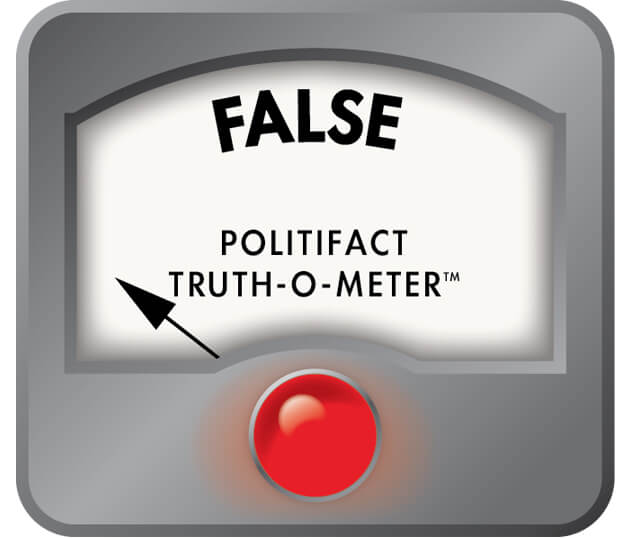
Cities can also finance new growth with subsidies from other parts of the city. For example, multinational corporations that own skyscrapers pay you a collective $1 billion in property taxes, and yet the downtown area only requires $900 million in expenses. So you spend the other $100 million subsidizing poorer people, like building and maintaining infrastructure for the people who own houses in the suburbs.

The best part is that Strong Towns themselves showed how this works. You do not need every new development to pay for its costs for the city to remain financially sustainable. That’s an asinine premise.
Of course, with the suburban model, it is physically impossible for a city of finite dimension to grow indefinitely, let alone at amounts that accelerate forever. Even realtors are now starting to acknowledge that assumption #2 is not true. Later this week we’ll show how assumption #1 is also not true, and by extension, why our pattern of development is a classic Ponzi scheme, one that we cannot fix or “recover” from.
Suburban development can’t possibly pay for itself in the long term, he claims. Therefore any suburbs that aren’t expanding must be insolvent. Therefore the existence of just one of these suburbs must prove his entire theory wrong.

Luckily, Charles Marohn knows this, so he painstakingly researched every suburb in America, looked at their finances, and –
Chuck Marohn’s “Growth Ponzi Scheme” series is five parts long. At no point in the intro does he give us a single source. For an introductory piece this could be acceptable, except that in the other four pieces there are also no sources.
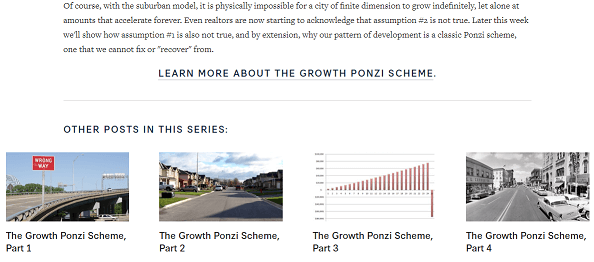
I put off working on this piece for so long because Charles Marohn isn’t quite the LOLcow that Not Just Bikes, Adam Something, Alan Fischer, and the rest of the YouTube Urbanite Twats are.

Instead, he’s a boring midwit who has no real evidence for the claims that he presupposes are true. He absolutely refuses to quantify things which should be easily quantifiable. He makes basic leaps of logic that aren’t supportable. However, he’s not quite at the level of an NJB, eager to push easily debunked claims such as the Cadillac Escalade having less interior space than a Subaru Outback.

I still can’t get over this.
But he gets better, where by better I mean more humourously incorrect. In the next installment we go over his case studies “proving” that both suburbs and small towns are Ponzi schemes.











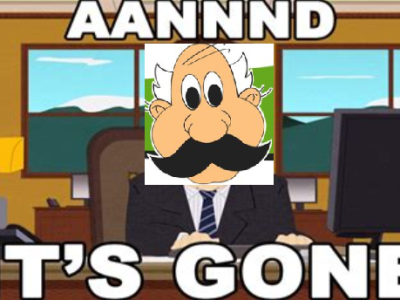


I like how you simplify and destroy these “soy” arguments.
I am starting to think that the ultimate soy-boy housing model is the senior citizen’s group home: Everything there is nice, gated, quiet, and walkable; meals and snacks are all in; there is community shuffleboard 24/7; and every Wednesday the van takes residents downtown for a shopping expedition.
Idyllic living, perhaps – yet primarily designed to keep the frail and weak from harm, and to generally keep them out of the way.